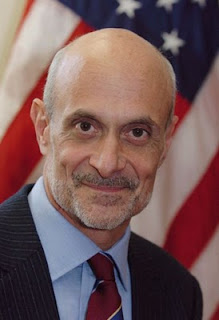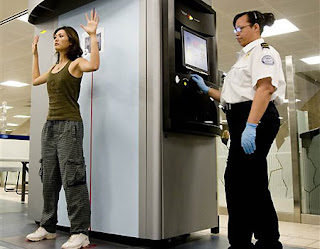Gonzalo Lira takes A Full Body Scan of American Corruption and finds Michael Chertoff, a classic example of the kinds of conflict of interests that characterize high level government-corporate relations. – Ilene
Courtesy of Gonzalo Lira
In the United States, if a policeman stops you for a traffic violation, and you offer him a $20 bill to forget about the whole thing, you’ll likely end up in jail.
But if you leave your Federal government job and go work as a consultant to the very industry you used to regulate, you won’t go to jail—you’ll grow rich. Very rich.
Michael Chertoff is the poster boy for this institutionalized corruption going on in America today. He is not unique. He is not an outlier of any bell curve. If anything, Chertoff’s form of corruption is average—it’s ordinary. It’s what everyone is doing: Everything within the law, everything that the law says he ought to be doing—yet the net effect is a blatant corruption that is personally despicable, and socially disastrous.
Michael Chertoff was the head of the Homeland Security Agency from February of 2005, to January of 2009. But after he left, he formed an outfit called The Chertoff Group and was promptly hired by an obscure company called Rapiscan Systems.
These body scanners are supposed to spot explosives, weapons, and other “tools of terrorism”. As in the picture to the right, you get zapped by magic rays, and the Transportation Security Administration (TSA) worker checks the monitor to make sure you haven’t brought a bomb on board the plane.
On its face, airport body scanners seem eminently sensible: A way to thoroughly make sure that no terrorist gets on board a plane with all the makings of a bomb.
Michael Chertoff is currently making the rounds of all the TV and cable talk shows, giving the song-and-dance routine about airport body scanners, and how they are “an effort to prevent terrorism”—how they bring about “enhanced levels of security”—how they are “a proactive approach to safety and security”—all the same old tired bullshit that is the same empty, hysterical clarion call that we’ve heard over the last decade: Safety!-Safety!-Safety!-Safety!
The reason I dismiss Mr. Chertoff’s media appearances—and dismiss everything he has to say on the subject—is because the airport body scanners he is singing the praises of? They are manufactured by Rapiscan—The Chertoff Group’s biggest client.
In other words, Michael Chertoff is not some kindly old éminence gris, looking after what’s best for the United States out of his boundless patriotism—
No: He is the paid spokesman for the manufacturer of the airport body scanners. And he stands to profit from the implementation of these airport body scanners. Profit directly.
- Body scanners are not inherently superior to other methods of preventing unlawful items from being taken on board an airplane. The very fact that an individual can (currently) “opt out” of a body scan, and instead be manually patted down proves that scanners do not have an inherent advantage over low-tech solutions.
- Body scanners are extraordinarily expensive—$150,000 each—a cost which might be better applied to hiring more TSA workers, and thereby increasing the flow-rate of passengers through security, which currently has reached bottle-neck proportions.
- Body scanners represent an as yet unquantified but real health danger. (I will discuss the specifics below).
- Body scanners are an obvious breach of civil liberties—a clear violation of the Fourth Amendment (unlawful search and seizure) and the rule of probable cause . . . unless we are going to redefine “probable cause” as meaning all airplane passengers by definition are likely engaged in criminal activity, and therefore there is probable cause to essentially strip-search each and every one of them.
Which would have been fine—if Chertoff hadn’t immediately upon resigning his post created The Chertoff Group, and then gone to work for Rapiscan: The manufacturer of these body scans.
Was there a “relationship” between Chertoff and Rapiscan before he exited the Federal government? I don’t know—and I would guess that Chertoff is too shrewd to have been on the pay of Rapiscan back when he was Secretary of HSA.
But certainly as the head of The Chertoff Group, Michael Chertoff is in the pay of Rapiscan now. What, you think high-powered lobbying comes for free?
There are essentially two types:
- Backscatter X-ray Scanners: These fire x-rays which, rather than going through the body, bounce off the skin and other objects. A computer interprets this reflection (“backscatter”), and creates an image.
- Millimeter Wave Scanners: These fire microwaves in the 0.1 mm to 1 mm range, between microwaves and the infrared spectrum. Some marketers claim that millimeter waves are different from Terahertz radiation (which sounds very scary)—but they are essentially one and the same. Exactly as backscatter x-rays, millimeter waves go through clothes but reflect off of skin. Similarly, a computer interprets this reflection, and creates an image.
Both of them present health concerns—not hippy-dippy faggotty-assed pussy concerns, but reasonable health concerns any sensible person would be foolish not to take seriously.
To start with the first: Backscatter x-ray scanners fire low levels of x-rays—much less energy than the kind normally used to x-ray a broken limb in a hospital, for instance.
Proponents of backscatter x-ray scanners argue that the x-rays of this type of scanner do not penetrate the skin—so therefore, harmful x-ray radiation does not build up in the body.
This is bullsh*t. To be fair, at this time, it is not clear from the current evidence if this type of low-level x-ray radiation does not build up inside the body—but it certainly bombards the skin of the subject. That’s the whole point of the backscatter x-ray scanner: To have x-rays bounce off the subject’s skin, and thereby create an image of what they might be carrying beneath their clothes.
Therefore, the concentration of x-rays on the skin is much higher than a more powerful x-ray passing completely through the body. Here is a letter from a group of biochemistry and biophysics professors from the University of California San Francisco, raising precisely this concern, discussing the physics in detail.
Regardless of whether x-rays build up on the skin or in the body itself, there is no question that, just like medical x-rays, repeated uses of backscatter x-ray scanners leads to build up of harmful radiation, which will eventually—and inevitably—lead to cancer. That’s because x-rays have a cumulative effect: Each dose of x-rays adds to the effect of a previous dose.
The ways x-rays cause cancer is, the photons ionize atoms in cells. The chemical bonds therefore break down—the cells literally rip apart, including DNA. This can in time lead to cancer. The direct causal link between excessive doses of x-rays and cancer and/or leukemia is a non-controversial statement.
Who are the ones who face a disproportionate risk of developing cancer and/or leukemia from backscatter x-ray scanners? Obviously, airplane crews: Because of the ridiculous TSA mandate that even the pilots of the planes have to be checked to make sure they’re not bomb-carrying terrorists, and since of course airplane crews have to wend their way through the airport body scanners multiple times per week in order to do their jobs, then obviously it is inevitable that they will develop cancer and/or leukemia from backscatter x-ray scanners. Inevitable.
But in perhaps some poetic justice, the people most likely to suffer cancer in the long term (and maybe not so long term) are the TSA workers operating the machines. You see, there is a reason that in every hospital, the x-ray room is sealed off, and x-ray operators always work behind lead shielding. Yet TSA employees stand around these backscatter x-ray scanners for hours on end, day after day, with no shielding or protection. It’s a safe bet to claim that TSA workers operating these machines will suffer disproportionate amounts of cancer and/or leukemia in the medium- to long-term future.
Poor dumb bastards.
Millimeter wave scanners, on the other hand, use less energetic particles than backscatter x-ray scanners. And unlike x-rays, terahertz radiation does not seem to accumulate in the body.
This ought to sound like good news: The photons of millimeter wave scanners are less energetic, therefore unlikely to ionize atoms and therefore rip apart DNA—so no cancer. Right?
Right?
Well . . . It turns out, researchers at Los Alamos National Laboratory have discovered that terahertz radiation is not energetic enough to ionize atoms—but itis energetic enough to essentially “shake” DNA until the strands “unzip”, creating “bubbles” in the DNA strand, hindering replication.
These researchers discovered that the damage to DNA was “probabilistic rather than deterministic”, which explains why some (pro-scanner) experiments produced no damage to DNA, while other identical experiments did produce damaged DNA—sometimes terhertz radiation rips apart DNA, and some other times it doesn’t. Here is a layman’s explanation of their work, in the Technology Review of MIT from last October 30, 2009, and here’s their academic paper in PDF.
This means that, unlike backscatter x-ray scanners, millimeter wave scanners do not create a build up of harmful radiation in the body. However, the probability of terahertz radiation causing damage to DNA—and ultimately cancer and/or leukemia—is a numbers game: Sooner or later, your number’s up.
To put it simply: Imagine you have a revolver that, rather than six chambers, has a thousand chambers—and only a single bullet. You can play Russian Roulette with this gun quite confidently once, twice, three times, maybe even four times. But eventually, you’ll start getting nervous—because you know the odds will start to rise uncomfortably.
And if during a busy day, thirty or forty thousand people pass in front of this one-bullet-in-a-thousand-chambers gun, what will happen? Why, that’s easy: At the end of the day, thirty or forty people are going to be lying dead with a bullet between the eyes—because those are the odds.
Now, what are the odds of terahertz radiation producing cancer and/or leukemia? No one knows yet, because the technology is too new. Maybe it’s not one in a thousand—maybe it’s one in a million.
Fine: Would you like to be that one-in-a-million?
Or put it another way: During the upcoming Thanksgiving holiday, something like 24 million Americans are going to be flying. Therefore, with one-in-a-million odds, and since those 24 million Americans are likely flying round trip, at the end of Thanksgiving Weekend, 48 Americans will be dead—because of this technology.
Or put yet another way: In 2009, according to the Department of Transportation, 769 million passengers flew in the United States. With one-in-a-million odds, that would be 769 dead passengers—that would be two full jumbo-jets’ worth of passengers.
How many people died of airplane terrorism in 2009?
This, of course, is the calculus that must be made: What is the cost of this protection? And is the cost substantially less than what is being prevented?
If scanners had been in place in every airport in America in 2009, and assuming a one-in-a-million rate of lethal effects from either one of the two types of full body scanners, that would mean 769 Americans would die.
Yet in 2009, there were no deaths from airplane terrorism. In fact, since September 11, 2001, there haven’t been any deaths from airplane terrorism in the United States.
So imagine if during the nine years since 9/11, one in a million passengers going through the airport scanners had died as an effect of those scanners. That would be roughly 7,000 people who would have died of cancer and/or leukemia, in order to prevent . . .
. . . nothing.
Now on top of this cold-blooded, rational calculus as to the cost-effectiveness of the airport scanners, we have to face up to a particularly painful fact:
These scanners don’t work.
When I say, “The scanners don’t work”, I mean, the scanners don’t fulfill the function for which they were intended: They do not catch potential terrorists bringing bomb-making equipment on board an airplane.
Continue reading A Full Body Scan of American Corruption here.




